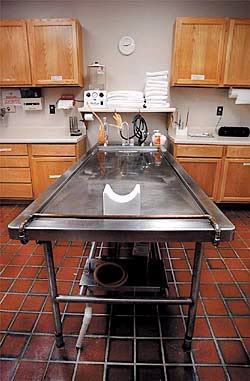- Embalming is rarely required by law. The Federal Trade Commission and many state regulators require that funeral directors inform consumers that embalming is not required except in certain special cases. Embalming is required when crossing state lines from Alabama, Alaska, and New Jersey. Three other states — Idaho, Kansas, and Minnesota — require embalming when a body is shipped by common carrier.
- Embalming provides no public health benefit, according to the U.S. Centers for Disease Control and Canadian health authorities. Hawaii and Ontario forbid embalming if the person died of certain contagious diseases. Many morticians have been taught, however, that embalming protects the public health, and they continue to perpetrate this myth.
- Embalming does not preserve the human body forever; it merely delays the inevitable and natural consequences of death. There is some variation in the rate of decomposition, depending on the strength of the chemicals and methods used, and the humidity and temperature of the final resting place.
- Ambient temperature has more affect on the decomposition process than the time elapsed after death, whether or not a body has been embalmed. In a sealed casket in above-ground entombment in a warm climate, a body will decompose very rapidly.
- Embalming is a physically invasive process in which special devices are implanted, and chemicals and techniques are used to give an appearance of restful repose. The normal waxy-white color of a dead body is replaced with a more life-like tone by the use of dyes in the embalming fluid.
- Embalming chemicals are highly toxic. Embalmers are required by OSHA to wear a respirator and full-body covering while embalming. Funeral home effluent, however, is not regulated, and waste is flushed into the common sewer system or septic tank.
- Refrigeration is an alternative to maintain a body while awaiting a funeral service or when there is a delay in making arrangements. Not all funeral homes have refrigeration facilities, but most hospitals do.
- Embalming has no roots in Christian religion and is common only in the U.S. and Canada. Embalming is considered a desecration of the body by orthodox Jewish and Muslim religions. Hindus and Buddhists choosing cremation have no need for embalming.
- Private or home viewing by family members and close friends can occur without embalming and is far more "traditional" than some of the services promoted by the industry under that name.
- The funeral industry promotes embalming and viewing as a means to show "proper respect for the body," and to establish the "clear identity" of the corpse so that the reality of death cannot be denied by those who view the body. Many funeral directors are convinced that seeing the body is a necessary part of the grieving process, even if the death was long anticipated.
- Few funeral directors will participate in the public viewing of a body without embalming and cosmetic restoration. While some people may be comforted by "a beautiful memory picture," as it's called in the trade, 32% of consumers reported that viewing was a negative experience, according to a 1990 survey.
- Embalming gives funeral homes a sales opportunity to increase consumer spending (by as much as $3,000 or more) for additional body preparation, a more expensive casket with "protective" features perhaps, a more expensive outer burial container, and a more elaborate series of ceremonies.
"I think the elaborate expensive display of an open casket with all the makeup in the slumber room enforces the belief that the person is only asleep, and in my personal opinion would only help to prolong the stage of denial."
Elisabeth Kübler-Ross in
No comments:
Post a Comment